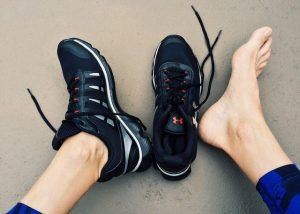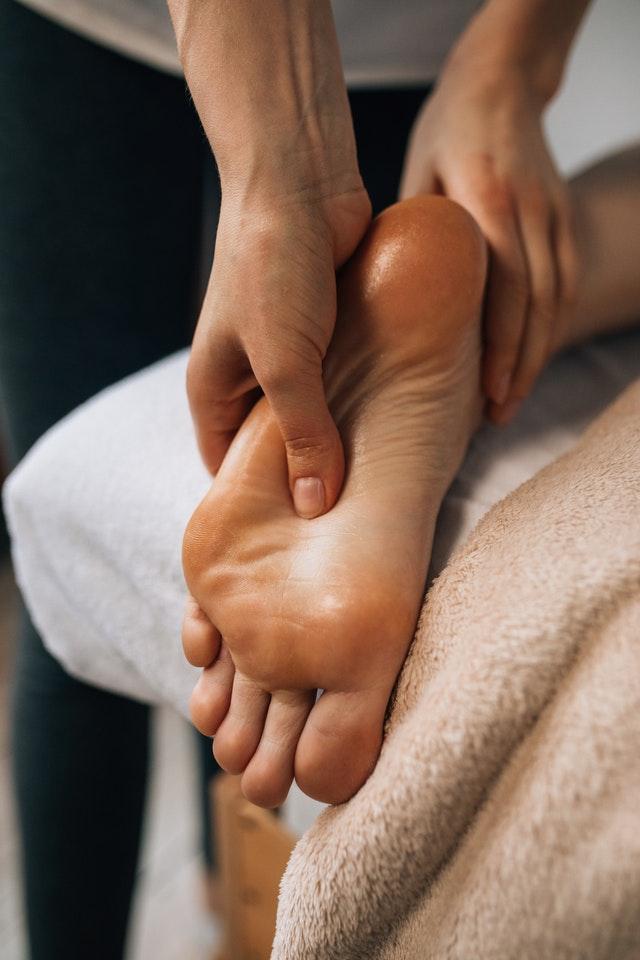
Diabetic Feet Swollen?
Are your diabetic feet swollen?
You are at an increased risk of developing serious diabetic foot issues if you have either type 1 or 2 diabetes and high blood sugar levels.
Diabetic foot care is critical, and it is up to you to deal with your situation. Every year, up to 100,000 adults undergo diabetes-related lower limb amputations in the USA alone.
Luckily, there is a way to help you avoid developing severe diabetic foot problems. Following the proper diabetic foot care routine is an excellent way that can help you stay away from foot complications.
Additionally, the best way you can prevent foot problems is by keeping your blood sugars in range and ensuring your HbA1c is below 7%.
Further, you can considerably help reduce the risk of diabetic foot issues by wearing recommended footwear for diabetes and neuropathy, getting your early diabetic foot exams, and following a flawless diabetic foot care routine.
Why Is Diabetic Foot Care Important?
You are at a higher risk of developing severe foot issues than the general population if you have diabetes.
Two main complications are likely to arise should you not manage your diabetes properly. The two main complications are diabetic peripheral neuropathy (DPN) which damages the nerves in your feet, and peripheral artery disease (PAD), which impedes proper blood circulation in your lower limbs.
Diabetic foot care can considerably prevent these two main complications that may lead to you having severe foot issues.
Diabetes damages the nerves in the feet

Peripheral neuropathy affects around 50% of persons that have type 2 diabetes. If you have type 2 diabetes, the nerves of your body’s extremities (feet and hands) are likely to be damaged by high blood glucose over time.
There is a variety of symptoms caused by damaged nerves ranging from mild to extremely debilitating. Further, the symptoms of diabetic neuropathy vary from one individual to the other. Some of the symptoms associated with diabetic neuropathy include:
- Cramps
- Diabetic foot pain
- Tingling
- Burning sensations
- Loss of feeling (numbness)
- Loss of balance
- Increased sensitivity to touch
If you are diagnosed with diabetic peripheral neuropathy, good foot care is essential for you. Good foot care is vital for you since it can likely help in the following:
- Slow down the progression of your nerve damage
- Reduce or get rid of the pain
- Prevent complications that may happen further such as infections, diabetic foot ulcers, and in the worst-case scenario, lower-limb amputations.
Diabetes reduces blood circulation in the feet.
You are at an increased risk for peripheral artery disease if you have diabetes. This is because a sticky plaque of fats and cholesterol builds up on the walls of your arteries.
The build-up on the walls of your arteries can slow down blow circulation drastically, and this can lead to the lack of delivery of oxygen and nutrients to your lower limbs and feet. You are at risk of increased foot infections, foot ulcers, and even foot gangrene with PAD.
Apart from preventing most complications caused by peripheral artery disease, diabetic foot care can also help boost blood circulation and decrease swollen feet.
Diabetic Foot Care Guidelines
Diabetes is harmful to your feet, and if you have it, poor diabetic foot care can result in having to amputate your toes, foot, or even your leg.
You might not notice an infection from a small cut or blister until it is too late. If you have either type 1 or 2 diabetes, you must adhere to a strict daily schedule at home to care for your feet. This is especially true if you have been identified as having peripheral artery disease or diabetic neuropathy.
Diabetes foot care guidelines that can help you prevent the most serious complications
1. Keep your HbA1c below 7%
Your blood sugar level has the utmost impact on the health of your feet. When you have diabetes, and it is not managed properly, and your blood glucose levels are not controlled, you are likely to have diabetes-related foot complications.
Therefore, if you want to stay away from foot problems, the first rule is to ensure that your HbA1c is kept below 7% and your blood sugars are in the range.
Following a healthy lifestyle, taking your medications, balancing your meals, exercising daily, and asking your doctor for advice regularly is the best way to keep your HbA1c below 7% and your blood sugars in range.
2. Get a diabetic foot exam once a year.
Medicare will pay for yearly foot tests for diabetic peripheral neuropathy patients. A podiatrist, your general practitioner, or another healthcare professional will perform a series of painless and risk-free medical tests.
Diabetes foot exams can identify issues that you might not be able to notice on your own.
It is advisable that you see your doctor immediately if you notice or feel any of the following apart from your yearly diabetic foot exam:
- If you have pain in your feet or legs
- Prickling sensations, burning or tingling
- Numbness or loss of sensation
- Should you notice any deformities on your toes or feet
- Loss of hair
- Cracks on your skin
- Any changes in your skin color
- When your toenails turn yellow
- Fungus infections
- Ingrown toenails, ulcers, sores, or blisters
You can considerably reduce the risk of foot problems and their aggravation through early diagnosis and prevention.
3. Inspect your feet daily
Diabetic neuropathy can lead to cuts and wounds staying unnoticed because of possible decreased sensation (numbness) in your feet.
Therefore, it is advisable that you inspect and check each side of your feet and toes on a daily basis. When inspecting your feet, you should check if your feet have redness, blisters, cuts, swelling, nail issues, bruises, calluses, and many more.
While inspecting your feet, it is also essential to check in between your toes and under your feet. You can use a mirror if you are physically unable to do so.
Additionally, if you have diabetes, you should never try to treat a foot problem by yourself. You should consult your doctor for advice if you notice anything unusual.
4. Gently wash and dry your feet.
If you want to avoid diabetes-related foot problems, then foot hygiene is a must. It would be best if you washed your feet daily in lukewarm water.
Using cold or too hot water is not advisable since it could do damage to your skin. While washing your feet, you should use a gentle foot wash or a mild soap. To dry your feet and between your toes, you should gently pat or blot your feet.
5. Wear shoes for diabetes & neuropathy
You can help prevent and alleviate the most common diabetic foot problems by donning diabetic shoes.
Diabetic shoes are different from regular shoes since they are medically and professionally designed for this purpose. These shoes are equipped with unique features that prevent and alleviate problems related to common diabetic feet.
The features include the protective inner linings that help in preventing your foot from blistering and irritating. Additionally, for improved foot stability and overall balance, diabetic shoes have enhanced foot support and extra-cushioning.
The shoes have a non-binding design which aids in the promotion of blood circulation to your foot. When it comes to neuropathy shoes, they are even more protective than diabetic shoes despite having almost similar features. Depending on your needs, you should consider having at least a pair.
Moreover, the pair of shoe fitting is essential. You should ensure that the diabetic shoes or neuropathy shoes are not too loose or too tight.
You can confirm this by inspecting the shoes before inserting them into your feet. Last, you should also ensure that there are no pebbles or foreign objects in the shoes that could harm your feet before wearing them. Too tight shoes with foreign objects or pebbles may lead to your diabetic feet getting swollen.
6. Consider socks for people with diabetes.
Socks are also essential in playing a role in diabetes foot care. You should change your socks on a daily basis if your feet sweat a lot to ensure your feet stay dry.
Additionally, the socks you wear should also be dry. If you have cold feet, especially at night when sleeping, it is recommended to wear socks to keep your feet warm. The socks also should not be too tight to compress your feet.
Diabetic socks have unique features. Some of the impressive features of diabetic socks include their soft elastic or no elastic at all. This will help in allowing blood flow to your feet by not constricting your leg and blocking blood flow.
These socks also will ensure that your feet stay in a dry, healthy environment thanks to the anti-bacterial fabrics used in making them.
The breathability of the socks will allow optimal airflow to your feet, while the moisture-wicking features in the socks will help in getting rid of any sweat and moisture hence leaving your diabetes feet dry and comfortable.
Furthermore, diabetic socks are designed to prevent blistering and irritations on your feet since they have extra padding for extra comfort and seamless construction.
7. Moisturize your feet
Your skin can be affected by dehydration caused by high blood sugars. The effects of dry skin include skin peeling, crackdown, or itch, which may cause further issues to your diabetic feet, such as foot ulcers and infections.
You should apply moisturizing lotion after washing your diabetic swollen feet every time after washing if you have dry skin on your feet. However, you should not apply moisturizing lotion between your toes since it may cause a fungal infection.
Further, there are moisturizers and foot care products of poor quality, and using them can be harmful to your diabetic feet.
Diabetic skins are fragile, and using poor quality products and moisturizers that contain chemicals can be too aggressive for your skin despite also not being efficient.
Therefore, it is advisable that you go for diabetic creams and lotions that have been carefully formulated. Only if you have dry skin should you use a moisturizer. If not, and your skin does not feel rough, you should wash and dry your feet each time after washing.
8. Keep your feet dry
Despite your feet needing to stay dry if you have diabetes foot issues, the skin of the feet should always stay moist. Dry feet are necessary with diabetic swollen feet since moist areas aid the development of fungal and bacterial infections. After being under the rain or snow, you should not let your feet stay wet for too long. If necessary, you should wear or use waterproof shoes.
You should choose appropriate socks and shoes with moisture-wicking and anti-bacterial fabrics if you tend to have swollen diabetic feet. It would be best if you changed your socks any time, they were wet.
9. Keep your feet warm.
People with diabetes tend to have cold feet because of poorer blood circulation. Generally, skin irritation, dryness, and foot problems are likely to increase due to cold.
Therefore, if you have diabetes feet, you should ensure that your feet are kept warm. However, they should not be too warm since too much warmth causes sweat.
It would be best if you chose socks with quality materials such as Merino wool, Alpaca fibre, or thick bamboo fibers during the winter and cold seasons to keep your feet warm. If needed, wear socks at night to keep your feet warm.
10. Trim your toenails properly
You may have foot issues such as ingrown toenails that can easily get infected if you trim your toenails badly. Additionally, at least once every week, you should inspect and clip your toenails.
- After taking a bath or shower, when your toenails are softer and more flexible, trim them.
- Make a straight cut across with a nail clipper. Avoid trimming the sides or rounding the corners.
- Avoid having your toenails cut too short. Leave around one millimeter of white showing at the tip of your nail.
- Never pull the cuticles back. They aid in preventing the entry of bacteria and infection into your nail matrix.
- To avoid jugged edges after clipping, smooth your nails with a nail file.
Can diabetics soak their feet?
You can help calm down neuropathy symptoms by soaking your feet in a basin filled with warm water or in a foot spa.
An excellent way to incorporate natural pain-relieving and soothing ingredients such as Epson salts, essential oils for neuropathy, medicinal herbs, or cannabidiol (CBD) products are to soak your feet in a basin of warm water or foot spa.
In conclusion, foot soaking is great, and it can help persons living with diabetic neuropathy foot pain. However, foot soaking is not a treatment for diabetic neuropathy.
Soaking your feet cannot repair damaged nerves but can relieve diabetic nerve pain. Any way to reverse diabetic peripheral neuropathy has not been found or proven scientifically up to date.
Therefore, soaking your feet in Epsom salts or apple cider vinegar has a well-appreciated pain-relieving effect you would be fond of, but it would not reverse neuropathy.
Foot soaks can help relieve nerve pain.
You can reduce nerve pain in your diabetic nerve pain feet by soaking them in warm water.
Additionally, while soaking and bathing your diabetes feet, you can take the opportunity to try some other home solutions for neuropathy.
You can do this by adding Epsom salts, medicinal herbs, or essential oils. You can be provided instant relief for neuropathic pain through warm water baths and foot soaks.
Warm water baths and foot soaks have proven to do the following:
- Relieve pain
- Reduce stress
- Relax muscles
- Increase blood circulation
Foot soak is no danger for persons with diabetes or neuropathy if used reasonably and wisely. However, you should be aware that your feet are fragile and prone to multiple conditions once your feet are affected by neuropathy and diabetes.
Therefore, to avoid injury, you should:
- The damaged nerves in your feet are not reliable enough for judging water temperature, and you could burn your skin without even noticing it. Therefore, you should always check the water temperature with a thermometer.
- Dry your feet but gently soak, particularly in the space between your toes. This is because you can easily get wounded and infected if you have wet skin blisters.
- Limit your soak time. More than 30 minutes of foot soaking time, three to four times per week, can weaken your skin’s barrier of defense.
- Take care when adding items to your foot bath. Some online foot soak recipes for neuropathy are too forceful and could harm you. It is advisable that you consult your doctor for advice first.


